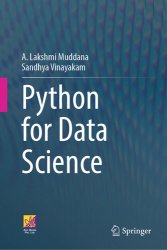Python for Data Science (2024)
- Добавил: literator
- Дата: 21-05-2024, 22:43
- Комментариев: 0
 Название: Python for Data Science
Название: Python for Data ScienceАвтор: A. Lakshmi Muddana, Sandhya Vinayakam
Издательство: Springer/Ane Books Pvt. Ltd.
Год: 2024
Страниц: 398
Язык: английский
Формат: pdf (true), epub (true)
Размер: 18.7 MB
The book is designed to serve as a textbook for courses offered to undergraduate and graduate students enrolled in Data Science. This book aims to help the readers understand the basic and advanced concepts for developing simple programs and the fundamentals required for building Machine Learning models. The book covers basic concepts like data types, operators, and statements that enable the reader to solve simple problems. As functions are the core of any programming, a detailed illustration of defining & invoking functions and recursive functions is covered. Built-in data structures of Python, such as strings, lists, tuples, sets, and dictionary structures, are discussed in detail with examples and exercise problems. Files are an integrated part of programming when dealing with large data. File handling operations are illustrated with examples and a case study at the end of the chapter. Widely used Python packages for Data Science, such as Pandas, Data Visualization libraries, and regular expressions, are discussed with examples and case studies at the end of the chapters. The book also contains a chapter on SQLite3, a small relational database management system of Python, to understand how to create and manage databases. As AI applications are becoming popular for developing intelligent solutions to various problems, the book includes chapters on Machine Learning and Deep Learning. They cover the basic concepts, example applications, and case studies using popular frameworks such as SKLearn and Keras on public datasets.
Python is a general-purpose programming language that is used to solve a variety of problems in different domains. It is widely used in Artificial Intelligence (AI), Data Science, Web Development, Internet of Things, etc. Python uses English-like syntax, easy to read and write code. Its vast library support, improved productivity, strong community base, portability, and availability as a free and open source make it very popular among all types of users.
The book covers basic and advanced concepts. The basic concepts like its unique features, data types, operators, and developing simple programs using selection and loop statements. As functions are the core of any programming, a detailed illustration of defining and invoking functions, recursive functions, and lambda functions is covered. Built-in data structures of Python are popularly used in Data Science and model building. Strings, Lists, Tuples, Sets, and Dictionary data structures are discussed in detail with example programming problems.
File handling is an important task when handling large data. Data access and manipulation from standard file formats such as CSV, Excel, and JSON files are included in the book. Python is widely used in data analytics and model building. Data manipulations using Pandas and Data visualizations using Matplotlib and Seaborn packages are illustrated with examples and case studies. Regular expressions being an important concept in Natural Language Processing, text manipulation functions are discussed, and a case study is presented with public text data. SQLite3 libraries are discussed for creating and manipulating data in the database.
Advanced concepts of building Machine Learning and Deep Learning models and multi-tasking concepts are explained with examples and case studies. The Machine Learning chapter discusses concepts of supervised and unsupervised learning and model evaluation algorithms using the SciKit-Learn package. The case studies are presented for different learning algorithms using built-in and public datasets. Deep Learning is a sub-field of Machine Learning that mimics the human brain. Concepts of artificial neural networks for both structured and unstructured data are discussed in detail using the Keras library for deep learning. Case studies are presented for standard neural networks, convolutional neural networks, and recurrent neural networks using Keras libraries.
The book also includes a chapter on multi-threading and multi-processing in Python for improving execution time and effective utilization of system resources. Every chapter includes illustrations with examples, worked-out problems, multiple-choice questions for knowledge testing, and exercise problems for practice. Case studies are presented on advanced concepts. The book is supported by a solution manual for multiple-choice questions and exercise problems. The aim and scope of the book are to provide the required knowledge and skill in coding and data analysis. The book serves as the basis for data analysis and model building using Python packages. The reader requires basic maths and logical thinking and no other prerequisites.
The book is intended to serve as a textbook for the Problem Solving and Data Science courses of Engineering, Science, and Commerce programs at the undergraduate and postgraduate levels.
Скачать Python for Data Science
[related-news] [/related-news]
Внимание
Уважаемый посетитель, Вы зашли на сайт как незарегистрированный пользователь.
Мы рекомендуем Вам зарегистрироваться либо войти на сайт под своим именем.
Уважаемый посетитель, Вы зашли на сайт как незарегистрированный пользователь.
Мы рекомендуем Вам зарегистрироваться либо войти на сайт под своим именем.
